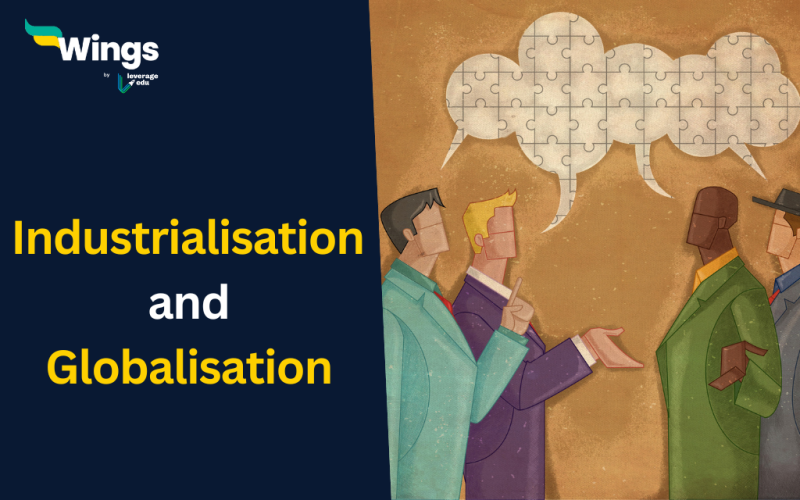Hey, guys! Mr. Owl 
Globalisation in simple terms: It’s the global exchange of ideas, products, cultures, and more, fostered by advances in transportation and communication, particularly the internet.
Industrialisation in simple terms: Industrialisation was a time when society transitioned from making things by hand to using machines in factories, drastically changing how we lived and worked.
As competitive exam aspirants, you might often come across terms like “Industrialisation” and “Globalization” in your studies. But what do these terms really mean, and how do they influence the world we live in today? Let’s break down these concepts, understand their significance, and explore the intricate connection between them.
Table of Contents [show]
 What is Globalisation?
What is Globalisation?
Globalisation is the process of international integration where world views, products, ideas, and cultures interact and merge. It has been on the rise since the mid-1980s, driven by advances in transportation and communication technologies, such as the Internet.
Four Aspects of Globalization: The International Monetary Fund (IMF) identified four fundamental aspects of globalization: trade and transactions, capital and investment movements, migration and people movement, and dissemination of knowledge.
Impact on Environmental Challenges: Globalization isn’t just about economics; it’s also linked to environmental challenges such as climate change, pollution, and resource depletion. It affects business, work organization, culture, politics, and the environment.
Must Read: Redrawal of National Boundaries: Meaning and Historical Significance
Economic Globalization
Economic Interdependence: Economic globalization refers to the increasing interdependence of national economies worldwide. It involves the movement of goods, services, technology, and capital across borders.
Globalization of Production and Markets: This aspect includes the globalization of production, markets, competition, technology, and corporations. It creates a global marketplace, essentially a single world market.
Industrial Revolution and Modern Globalization
A Turning Point: The Industrial Revolution in the 19th century is often considered a turning point in the history of humanity. It marked a fundamental transformation in the way we live and work.
Globalization Precursors: While globalization has deep historical roots, the large-scale globalization we know today began to take shape in the 19th century.
 Link Between Industrialization and Globalization
Link Between Industrialization and Globalization
- Industrial Revolution’s Impact: The Industrial Revolution had a profound impact on the process of globalization. It was a catalyst that allowed for the massive growth of global trade and interconnectivity.
- Changing Economic Landscape: Industrialization led to the transformation of traditional societies and created new opportunities for global competition, especially among European powers. It shifted the equilibrium from a self-sufficient society to one focused on massive production.
- Dependency Links: The need for raw materials and markets fostered dependency links between regions. As the amount of production increased, colonies became not only sources of raw materials but also markets for industrial commodities.
- Formation of Worldwide Financial System: Industrialization created an infrastructure for the emergence of a worldwide financial system that connected markets more tightly to each other. Financial services became a focal economic activity of early industrialized countries.
 How was Industrialization a push towards Globalisation?
How was Industrialization a push towards Globalisation?
- Mass Production and Lower Costs: Industrialization introduced mass production and lowered the cost of various products. It shifted society’s focus from self-sufficiency to a market-based economy, driving demand for goods and expanding economic activities.
- Globalization of Basic Needs: Unlike traditional trade, which was focused on luxury products, industrialization and globalization became centred around meeting the basic needs of ordinary people, increasing trade on a massive scale.
- Globalization Tied to Industrial Logic: While globalization has many facets, it is crucial to recognize that its main driving force remains the logic of industrial production. Most aspects of globalization are linked to trade, finance, investments, and standards, all components of industrial mentality.
- Global Market Structures: The global market structures we see today are rooted in the logic of industrial production, with capitalism creating a worldwide market that integrates all parts of the world, regardless of their level of development.
“Kiddos, I’ve answered all your queries with the utmost precision that I was capable of. Now, I’ll be taking my leave, but if you think I might have missed something, do check out the FAQ section or drop a comment. I always respond!
Also Read: World War 1: History and Causes | World History Notes
FAQs
The Industrial Revolution kick-started globalization by creating mass production, transforming societies, and driving global trade.
Globalization is connected to environmental challenges like climate change, pollution, and resource depletion, impacting our world’s sustainability.
RELATED BLOGS
In conclusion, industrialization was a pivotal force that propelled globalization to the extent we see it today. It was the engine behind the massive shift from self-sufficiency to mass production, transforming societies and economies.
Hope you have gotten all the relevant information about ‘Globalisation and Industrialisation’! If you want to know more about topics like this, then visit our general knowledge page! Alternatively, you can also read our blog on general knowledge for competitive exams!
 One app for all your study abroad needs
One app for all your study abroad needs












 Industrialisation and Globalisation: Meaning and Differences
Industrialisation and Globalisation: Meaning and Differences


 45,000+ students trusted us with their dreams. Take the first step today!
45,000+ students trusted us with their dreams. Take the first step today!
